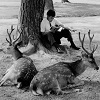Le Clézio in the Darién forests with the Emberá: a poetic rejuvenation
DOI:
https://doi.org/10.51777/relief12346Keywords:
J.M.G. Le Clézio, Darién, Emberá, radical otherness, ecocriticism, childhoodAbstract
Between 1970 and 1974, the writer J.M.G. Le Clézio traveled on multiple occasions, for six to eight months at the time, in the forests of the Darién region, at the border of Panama and Colombia. To this day, the Darién Gap is exempt of mass infrastructures et forms a vast natural zone that cuts the Americas in two halves. The aim of this article is to describe how the ecological awakening of the writer originates from his “Panamanian adventure”, and how it leads to an accrued sensibility towards minored peoples, such as the Emberá who welcomed him. This awakening is violent at first, and is expressed literary through the motif of the clash of civilizations. Afterwards, a slip towards a poetic renewal is observed, which culminates in L’inconnu sur la terre (1978). Drawing from primary sources (Haï, 1971; La fête chantée, 1997) and secondary sources (the many interviews the writer has given over the years), the modalities of transformation of the Leclezian poetic are assessed in the face of the central and intimate role that nature plays in it. In doing so, two periods of the writer’s life are related: the year he spent in Nigeria as a child in 1948 (as told in L’Africain, 2004), and the sojourns in the Darién, in his early thirties. These two periods colliding let us understand the return to wild life as the source of a poetic rejuvenation.

Downloads
Published
Issue
Section
License
Copyright (c) 2022 Simon Levesque

This work is licensed under a Creative Commons Attribution 4.0 International License.
Tous les articles dans RELIEF sont publiés en libre accès sous la licence Creative Commons Attribution 4.0 International License (CC-BY 4.0). Sous ce régime les auteurs conservent les droits d'auteur mais ils consentent à toute sorte d'utilisation de leur texte pourvu qu'il soit correctement cité.


